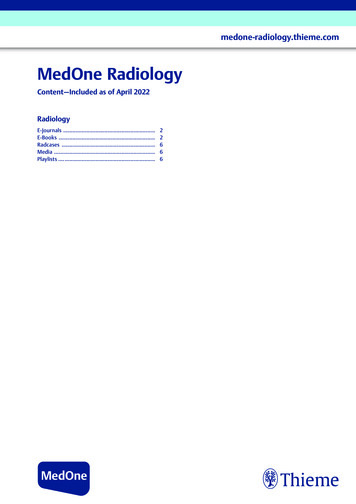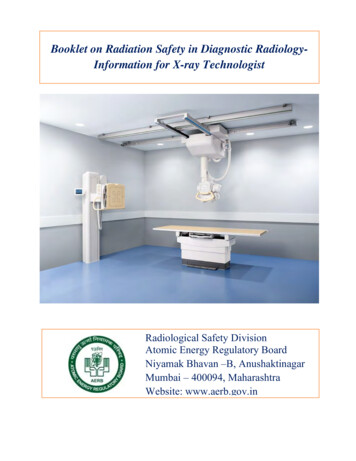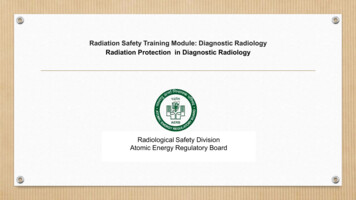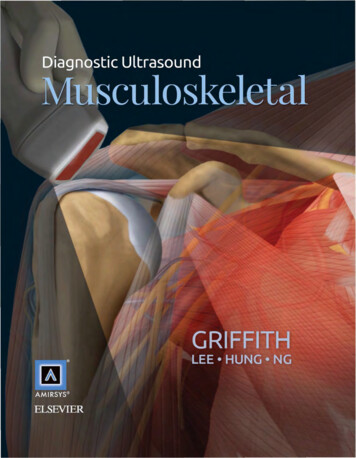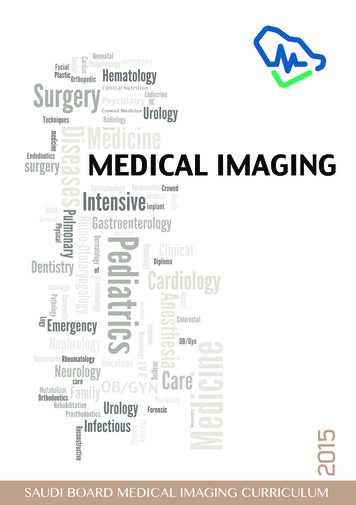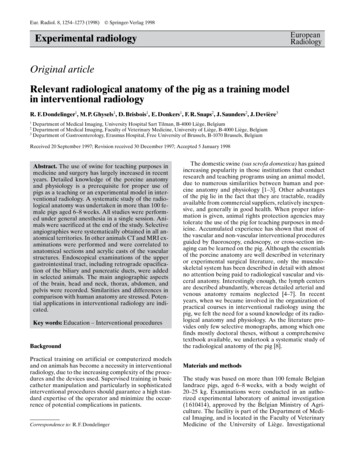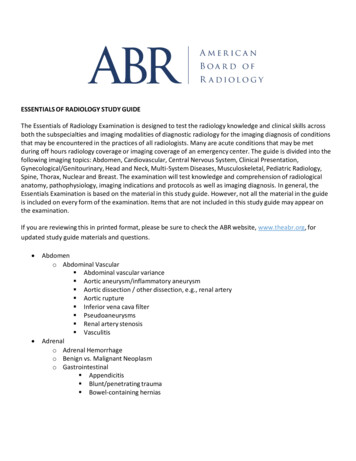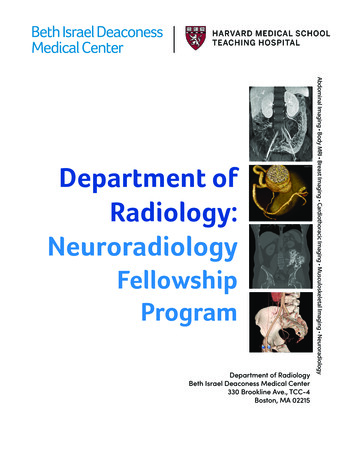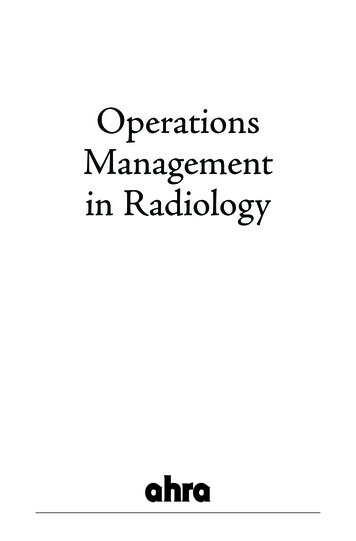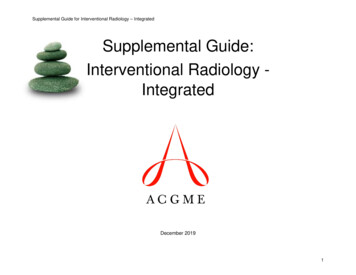
Transcription
Supplemental Guide for Interventional Radiology – IntegratedSupplemental Guide:Interventional Radiology IntegratedDecember 20191
Supplemental Guide for Interventional Radiology – IntegratedTABLE OF CONTENTSINTRODUCTION . 3PATIENT CARE . 4Reporting . 4Imaging Consultation. 6Image Interpretation . 8Pre-Procedural Consultation . 10Performance of Procedures . 12Post-Procedural Patient Care . 14MEDICAL KNOWLEDGE . 16Diagnostic Imaging Knowledge . 16Physics, Protocol Selection, and Optimization of Images . 18Imaging Technology and Image Acquisition . 20Pathophysiology and Treatment . 21Procedural Anatomy . 23Pharmacology . 24SYSTEMS-BASED PRACTICE . 26Patient Safety . 26Quality Improvement . 28System Navigation for Patient-Centered Care . 29Multidisciplinary Conferences . 31Population Health . 32Physician Role in Health Care Systems . 33Contrast Agent Safety . 35Radiation Safety . 37Magnetic Resonance Safety . 39Informatics . 41PRACTICE-BASED LEARNING AND IMPROVEMENT . 43Evidence-Based and Informed Practice . 43Reflective Practice and Commitment to Personal Growth . 45PROFESSIONALISM . 47Professional Behavior . 47Ethical Principles . 49Accountability/Conscientiousness . 51Self-Awareness and Help-Seeking . 53INTERPERSONAL AND COMMUNICATION SKILLS . 55Patient- and Family-Centered Communication . 55Interprofessional and Team Communication . 58Communication within Health Care Systems . 61MAPPING OF 1.0 TO 2.0 . 632
Supplemental Guide for Interventional Radiology – IntegratedMilestones Supplemental GuideThis document provides additional guidance and examples for the Interventional Radiology – Integrated Milestones. This is notdesigned to indicate any specific requirements for each level, but to provide insight into the thinking of the Milestone Work Group.Included in this document is the intent of each Milestone and examples of what a Clinical Competency Committee (CCC) mightexpect to be observed/assessed at each level. Also included are suggested assessment models and tools for each subcompetency,references, and other useful information.Review this guide with the CCC and faculty members. As the program develops a shared mental model of the Milestones, considercreating an individualized guide (Supplemental Guide Template available) with institution/program-specific examples, assessmenttools used by the program, and curricular components.Additional tools and references, including the Milestones Guidebook, Clinical Competency Committee Guidebook, and MilestonesGuidebook for Residents and Fellows, are available on the Resources page of the Milestones section of the ACGME website.3
Supplemental Guide for Interventional Radiology – IntegratedPatient Care 1: ReportingOverall Intent: To generate effective reports tailored to the care providerMilestonesLevel 1 Generates reports with appropriateelements for codingExamples For a complete abdominal ultrasound, writes report including history, comparison,technique, findings, all required anatomy, impressions/ conclusions For a procedure with moderate sedation, writes report including sedation type, time, andstatement of monitoring as well as any institutional requirementsDescribes lexicons and structured reporting Describes one of the lexicons used at their training site; describes structured reportingusedLevel 2 Efficiently generates clear and concise Creates a report for screening mammogram using appropriate lexicon and Breast Imagingreports that do not require substantive correctionReporting and Data System (BI-RADS) without major corrections in the description of thefocal asymmetry versus mass, when appropriateUses lexicons and structured reporting that donot require substantive correctionLevel 3 Efficiently generates clear and concisereports that rarely require correction Creates a report for a right subclavian port, but incorrectly describes the right jugularapproach Creates a report for liver mass characterization using appropriate lexicons and LiverReporting and Data System (LI-RADS); accurately describes the lesion and rarely hasgrammatical errors, when appropriateUses lexicons and structured reporting thatrarely require correctionLevel 4 Generates tailored reports meeting theneeds of the care provider and complexinterventional reports with appropriate elementsfor coding Chooses correct template and appropriately modifies the report but may include errors inspelling Creates a report (structured or unstructured) describing pancreatic carcinoma for thesurgeon to stage the tumor and make management decisions, when appropriateProficiently uses lexicons and structuredreporting to provide accurate and timely reportsthat do not require correctionLevel 5 Generates tailored reports meeting thereferring subspecialty needsAssessment Models or Tools Creates a complex catheter directed locoregional therapy report outside of standardtemplate. Includes microcatheter tip position for appropriate codingCurriculum Mapping Dictates a neck computed tomography (CT) report to include all required information inorder to stage the primary and the nodes in a P16 oropharyngeal cancer Direct observation Evaluation of the reports and feedback Faculty evaluations Multisource feedback 4
Supplemental Guide for Interventional Radiology – IntegratedNotes or Resources Elements for billing may change over time A substantive change would be a description that needs changes to the lexicons, i.e., BIRADS2 when it is BI-RADS4, right vs. left, or fails to modify template to reflect actual case Reports that have incomplete description of the findings. A bone lesion described as lyticbut description does not include additional information such as characteristics of theborders or internal matrix. This is a Level 2 report. Reports that come to appropriate conclusion but may require grammatical or syntaxcorrections. This would be a Level 3 Report. American College of Radiology. ACR-SIR-SPR Practice Parameter for the Reporting andArchiving of Interventional Radiology Procedures. Reston, VA: American College ofRadiology; 2014. ameters/ReportingArchiv.pdf?la en. Accessed 2019. American College of Radiology. ACR Practice Parameters for Communication ofDiagnostic Imaging Findings. Reston, VA: American College of Radiology; eParameters/CommunicationDiag.pdf?la en. Accessed 2019. RadReport. http://radreport.org/ RSNA Informatics. RadLex. http://radlex.org/. Accessed 2019. American College of Radiology. ACR BI-RADS Atlas. d-Data-Systems/Bi-Rads. Accessed 2019. Society of Interventional Radiology. SIR Coding Manual. https://www.sirweb.org/specialpages/search/?q coding manual. Accessed 2019. Society of Interventional Radiology. Standardized essed 2019.5
Supplemental Guide for Interventional Radiology – IntegratedPatient Care 2: Imaging ConsultationOverall Intent: To provide a high-quality imaging consultationMilestonesLevel 1 Uses electronic health record (EHR) toobtain relevant clinical informationLevel 2 For emergent and routine imagingconsultations, delineates the clinical question,obtains appropriate clinical information, usesevidence-based imaging guidelines, andrecommends next steps, with assistanceLevel 3 For complex imaging consultations,delineates the clinical question, obtainsappropriate clinical information, uses evidencebased imaging guidelines, and recommendsnext steps, with assistanceLevel 4 Manages imaging consultationsindependently, taking into consideration costeffectiveness and risk benefit analysisLevel 5 Provides comprehensive imagingconsultation at the expected level of asubspecialistAssessment Models or ToolsCurriculum MappingNotes or ResourcesExamples Looks up glomerular filtration rate (GFR) prior to protocol a study with intravenous contrast Reviews relevant history and laboratory results for a patient with abdominal pain Determines that patient has right lower quadrant pain, refers to American College ofRadiology (ACR) Appropriateness Criteria and suggests appropriate exam Determines that a pregnant patient has right lower quadrant pain, refers to ACRAppropriateness Criteria and suggests appropriate exam Primary care physician refers a patient with cirrhosis and a liver mass on ultrasound; theconsultation addresses the next step in management Provides consultation for a patient with a pacemaker and requires an magnetic resonanceimaging (MRI) A consultation is requested for a lung biopsy on a 25-year-old male patient who presentswith multiple lung masses on x-ray and a retroperitoneal mass on CT. The residentindependently recommends a scrotal ultrasound and tumor markers first A resident is consulted about a brain tumor and recommends advanced MRI inpreparation for biopsy or surgery Case conferences Direct observation Faculty evaluation Multisource feedback Report review of recommendations Routine represents those situations in which a resident is expected to provide consultationprior to call/float Complex represents those situations in which the patient has a complex clinicalhistory/presentation Consultations can be over the phone, in the reading room, at tumor boards, etc. Institutional policies American College of Radiology. ACR Appropriateness -Appropriateness-Criteria. Accessed 2019.6
Supplemental Guide for Interventional Radiology – Integrated American College of Radiology. ACR Contrast Manual ual. Accessed 2019. Image Gently. https://www.imagegently.org/. Accessed 2019. Society of Interventional Radiology. Clinical practice e-line/. Accessed 2019. Hopkins ACR Appropriateness Modules http://jhrad.com/acr/7
Supplemental Guide for Interventional Radiology – IntegratedPatient Care 3: Image InterpretationOverall Intent: To appropriately prioritize differential diagnosis for imaging findings and recommend managementMilestonesLevel 1 Identifies primary imaging findingsLevel 2 Identifies secondary and critical imagingfindings and formulates differential diagnosesLevel 3 Prioritizes differentialdiagnoses, and recommends managementoptionsLevel 4 Provides a single diagnosis, whenappropriate, with integration of currentguidelines to recommend managementLevel 5 Demonstrates expertise and efficiencyat a level expected of a subspecialistAssessment Models or ToolsCurriculum MappingNotes or ResourcesExamples Identifies intracranial hemorrhage Identifies abdominal aortic aneurysm (AAA) on computed tomography angiography (CTA) Identifies that a hemorrhage is in the parenchymal (rather than subarachnoid or extraaxial); generates differential considerations including tumor, stroke, trauma, vascular, andhypertension Identifies thickened wall around the AAA; generates differential considerations includinginfection, mycotic, impending rupture In the setting of an atraumatic hemorrhage, takes into consideration the hemorrhage is inthe basal ganglia and prioritizes hypertension In the setting of an atraumatic hemorrhage, takes into consideration the hemorrhage is inthe subarachnoid space, recommends CTA to look for aneurysm In the setting of acute abdominal pain, prioritizes impending rupture A CT of the brain shows M1 large vessel occlusion, determines how long since onset, andrecommends consultation with neuro-interventional specialist On serial CTAs, recognized growth of one (1) centimeter over past eight months andappropriately recommends urgent endovascular repair Identifies brain mass as tumefactive multiple sclerosis on pre-operative imaging andimmediately contacts surgeon to inform Recognizes that an AAA extending to the level of the renal arteries means that it will be acomplex endograft, and provides appropriate measurements Direct observation End-of-rotation evaluation Exam scores Multisource feedback Objective structures clinical examination Simulation The care of patients is undertaken with appropriate faculty supervision and conditionalindependence, allowing residents to attain the knowledge, skills, attitudes, and empathyrequired for autonomous practice. Background and Intent: The ACGME Glossary of Terms defines conditional independenceas: Graded, progressive responsibility for patient care with defined oversightACR8
Supplemental Guide for Interventional Radiology – IntegratedAppropriateness Criteria iatenessCriteria. Accessed 2019. Klein J, Vinson EN, Brant WE, Helms CA. Brant and Helms’ Fundamentals of DiagnosticRadiology. 5th ed. Philadelphia, PA: Lippincott Williams & Wilkins; ntals-of-DiagnosticRadiology/p/9781496367396. Accessed 2019. Wolf FJ, Grozdanovic Z, Albrecht T, Heidenreich J, Schilling A, Wacker F. DirectDiagnosis in Radiology: Vascular Imaging. 1st Ed. New York, NY: Thieme; roduct/1266-vascular-imaging. Accessed2019. Conferences Tumor Board9
Supplemental Guide for Interventional Radiology – IntegratedPatient Care 4: Pre-Procedural ConsultationOverall Intent: To ensure progressive development of knowledge and skill required to evaluate and manage patients prior to interventionMilestonesLevel 1 Gathers a complete history andperforms a physicalExamples Performs a complete history and physical exam and formulate treatment plan, but needsassistance in identifying most relevant findings and appropriate therapiesFormulates a pre-procedural assessment andplan with guidance from a faculty memberLevel 2 Gathers a focused history and performsa physical Functions across a variety of settings including clinic, emergency department, andinpatient wards Focuses physical exam and history, identify relevant issues and formulate basic treatmentplan with minimal guidanceFormulates a pre-procedural assessment andplan with minimal guidance from a facultymemberLevel 3 Chooses appropriate pre-procedurallaboratory and imaging studies Needs guidance in appropriate pre-procedure testing and final planIndependently formulates a pre-proceduralassessment and plan for common disordersLevel 4 Adjusts procedural plan based uponpre-procedural laboratory and imaging resultsIndependently formulates a pre-proceduralassessment and plan for complex disordersLevel 5 Mentors other learners in the preprocedural consultationDevelops patient care protocols/teachingmaterialsAssessment Models or Tools Provides appropriate independent consultation for common procedureso abscess drainageo nephrostomyo venous access May need assistance with complex procedures and critically ill patients Orders appropriate pre procedure testing as needed Independently provides pre-procedure consultation on complex and critically ill patients Adjusts management appropriately when care needs changeo acute MIo abnormal coagulation parameterso sepsiso shocko respiratory failure Develops patient teaching materials for women with uterine fibroids Updates pre-procedure antibiotic protocols for the department Direct observation Medical record (chart) audit10
Supplemental Guide for Interventional Radiology – IntegratedCurriculum MappingNotes or Resources Multisource feedback Objective structured clinical examination Society of Interventional Radiology. Guidelines: Clinical ne/. Accessed 2019. Society of Interventional Radiology. Clinical practice es/guidelines-by-document-type/. Accessed 2019. SIR Syllabus: Patient Care in Vascular and Interventional Business/Default.aspx?tabid 251&productId 3516745. Accessed 2019.11
Supplemental Guide for Interventional Radiology – IntegratedPatient Care 5: Performance of ProceduresOverall Intent: To ensure progressive development of technical skills required to perform proceduresMilestonesLevel 1 Performs basic procedures (e.g.,paracentesis, thoracentesis, non-targetedbiopsy)Examples Performs a paracentesis with effective real-time ultrasound visualization of needle tipEffectively uses basic image guidance (e.g.,visualize needle tip with ultrasound)Level 2 Performs advanced basic procedures(e.g., central venous access, targeted superficialbiopsy) Performs central venous line placement with real-time ultrasound guidance and confirmstip placement with fluoroscopyDemonstrates basic catheter and wire skillsLevel 3 Performs moderately complexprocedures (e.g., nephrostomy, diagnosticangiography) Understands available closure devices, selects appropriate device and successfullydeploys deviceIntegrates catheter and wire skills with imagingof complex anatomyLevel 4 Performs complex procedures (e.g.,transarterial chemoembolisation therapy[TACE], transjugular intrahepatic portosystemicshunt [TIPS], stent graft) Places percutaneous nephrostomy tube in obese patient with duplicated collecting systemIntegrates catheter and wire skills with advancedimaging guidance and device useLevel 5 Develops new techniques or toolsAssessment Models or Tools Incorporates intravascular ultrasound (IVUS) during TIPS placement Performs subselective catheter directed locoregional therapies with minimal assistance Researches new device development in cooperation with biomedical engineering Direct observation Evaluations Self-assessment Simulation lab Society of Interventional Radiology. Annual meeting and video ing-center-list/. Accessed 2019.Curriculum MappingNotes or Resources Performs an abdominal aortogram and crosses critical renal artery stenosis with wire andcatheter for intervention Uses cone beam CT appropriately during procedure12
Supplemental Guide for Interventional Radiology – Integrated Society of Interventional Radiology. RFS Trainee Website. http://rfs.sirweb.org. Accessed2019. CIRSE Library. https://library.cirse.org. Accessed 2019. Society of Interventional Radiology. Spring Practicum. page/fellows-spring-practicum/. Accessed 2019. IR Curriculum13
Supplemental Guide for Interventional Radiology – IntegratedPatient Care 6: Post-Procedural Patient CareOverall Intent: To ensure progressive knowledge base for the appropriate post procedure care of patients and the skills to manage postprocedure complicationsMilestonesExamplesLevel 1 Manages routine post-procedural care Places post angiogram orders for bed rest, groin checks, etc. and appropriately evaluateswith guidancepulses post procedure with the help of an upper level resident or faculty memberEvaluates post-procedural complicationsLevel 2 Manages post-procedural care withminimal guidanceManages minor post-procedural complicationsLevel 3 Formulates and implements postprocedural imaging and clinical follow-up forpatients after basic proceduresManages major post-procedural complicationsLevel 4 Formulates and implements postprocedural imaging and clinical follow-up forpatients after complex procedures Will see the patient when a nurse calls about oozing at the groin site, gathers appropriateclinical information and relevant clinical exam, and holds pressure until bleeding resolves Places post angiogram orders for bed rest, groin checks, etc. and appropriately evaluatespulses post procedure Concern for pseudoaneurysm on bedside exam, gets appropriate ultrasound exam andprepares patient for thrombin injection Orders follow-up cross sectional imaging in four weeks after catheter directed locoregionaltherapies to assess for response and arranges clinic visit In a patient complaining of a cold leg and pain after angiogram, performs appropriateclinical exam, imaging if appropriate or urgent intervention Orders most appropriate clinical follow-up and imaging for type II endoleak afterintervention based on procedure performed and patients symptoms/clinical scenarioAnticipates and mitigates post-proceduralcomplicationsLevel 5 Mentors other learners in postprocedural care and management ofcomplications For a patient on anticoagulation that needs an emergent angiogram, uses a smallersheath size or radial access to decrease risk of groin site complication Provides didactic curriculum to junior learners on post procedural care of patients afterangiogramDevelops a clinical pathway or guideline forpost-procedural careAssessment Models or Tools Develops department policy for closure device use Direct observation End-of-rotation evaluation Multisource feedback Quality and safety (M and M) presentations14
Supplemental Guide for Interventional Radiology – IntegratedCurriculum MappingNotes or Resources Society of Interventional Radiology. Quality and Safety oolkits/quality-and-safety-toolkit/. Accessed2019. Society of Interventional Radiology. Clinical practice es/guidelines-by-document-type/. Accessed 2019. Society of Interventional Radiology. Guidelines: Clinical ne/. Accessed 2019. SIR Syllabus: Patient Care in Vascular and Interventional EBusiness/Default.aspx?tabid 251&productId 3516736. Accessed 2019. American College of Radiology. Practice Parameters and Technical actice-Parameters-and-Technical-Standards.Accessed 2019.15
Supplemental Guide for Interventional Radiology – IntegratedMedical Knowledge 1: Diagnostic Imaging KnowledgeOverall Intent: To apply knowledge of anatomy, pathophysiology, and cellular and molecular systems to generate a differential diagnosisMilestonesLevel 1 Demonstrates knowledge of imaginganatomy Identifies pulmonary lobar anatomyDemonstrates knowledge of pathophysiology ofdisease processes Knows spectrum of primary lung pathologyDemonstrates knowledge of cellular andmolecular systemsLevel 2 Applies knowledge of anatomy to makecommon imaging diagnosesApplies knowledge of pathophysiology to makecommon imaging diagnosesApplies knowledge of cellular and molecularsystems to make common imaging diagnosesLevel 3 Applies knowledge of anatomy to makeuncommon imaging diagnosesApplies knowledge of pathophysiology to makeuncommon imaging diagnosesApplies knowledge of cellular and molecularsystems to make uncommon imaging diagnosesLevel 4 Proficiently integrates knowledge ofanatomic and molecular imaging withpathophysiology to formulate a diagnosisLevel 5 Proficiently integrates knowledge ofanatomic and molecular imaging withExamples Knows that lung cancer genomic profiling exists Knows thyroid anatomy, knows basic differential for thyroid nodule, knows the thyroidcancer can be derived from different cells Accurately identifies lobar pneumonia Uses positron emission tomography (PET) CT to diagnose lung cancer Accurately identifies a thyroid nodule on ultrasound, raises the possibility of toxicadenoma in a patient with a thyroid nodule and hyperthyroidism, uses I-123 uptake andscan to identify a hyperfunctioning thyroid adenoma Accurately classifies interstitial pneumonia Uses somatostatin receptor imaging to diagnose neuroendocrine tumor Identifies abnormal lymph node on ultrasound for follow up post-thyroidectomy in thyroidcancer patient, identifies a metastatic lymph node in patient with prior papillary thyroidcancer post thyroidectomy and new uptake in lymph node on I-123 whole body scan,recommends PET CT to evaluate for dedifferentiated thyroid cancer in post-thyroidectomypapillary thyroid cancer patient with new elevated thyroglobulin levels and a negativewhole body radioiodine scan Suggests sarcoidosis over malignancy on patient with metabolically active mediastinal andhilar lymphadenopathy and appropriately distributed pulmonary nodules Recognizes that genetic mutational status of lung cancer exists and guides intervention(fine needle aspiration versus multiple core biopsies), work-up, and treatment16
Supplemental Guide for Interventional Radiology – Integratedpathophysiology to formulate a diagnosis at theexpected level of a subspecialistAssessment Models or ToolsCurriculum MappingNotes or Resources Assessment of Case Conference Presentation Direct observation Faculty member evaluations Exam scores Report review Common imaging diagnosis refers to those diseases that one could expect to encounter inregular practice (e.g., pneumonia, pneumothorax, small bowel obstruction, renal stones,appendicitis, stroke, central nervous system bleed, pregnancy, cholecystitis, pulmonaryembolism, fractures) Uncommon imaging diagnosis refers to those diseases that one would not expect toencounter regularly (e.g., primary bone malignancy, pulmonary AV malformations,leukodystrophies, congenital heart disease, neuroendocrine tumors, interstitialpneumonia) Amin MB, Edge SB, Greene FL, et al. AJCC Cancer Staging Manual. 8th ed. New York,NY: Springer; 2017. rences/pages/default.aspx. Accessed 2019. World Health Organization. WHO Classification of Tumors. http://whobluebooks.iarc.fr/.Accessed 2019. American College of Radiology. Practice Parameters and Technical d 2019.17
Supplemental Guide for Interventional Radiology – IntegratedMedical Knowledge 2: Physics, Protocol Selection, and Optimization of ImagesOverall Intent: To apply knowledge of physics to optimize imaging, including dose reduction strategies, and minimizing risk to patientMilestonesLevel 1 Disc
This document provides additional guidance and examples for the Interventional Radiology –Integrated Milestones. This is not designed to indicate any specific requirements for each level, but to provi
